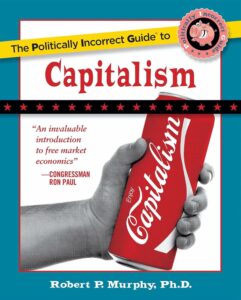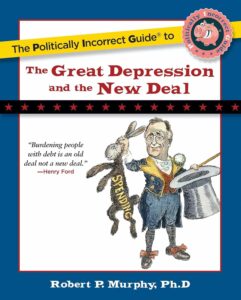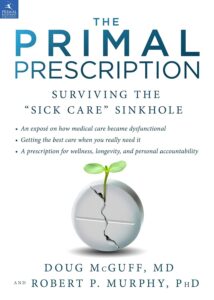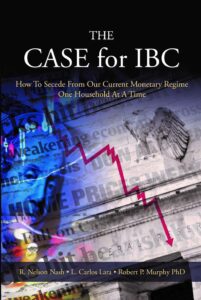Warren Buffett Bask
In his famous op ed in August, Warren Buffett wanted the government to stop coddling him and raise his taxes. He wrote that his federal tax bill was just under $7 million, and that what he “paid was only 17.4 percent of my taxable income.”
OK so presumably that’s because most of his income consists of realized capital gains, which are generally taxed at 15 percent.
However, I am trying to use IRS Form 1040, and pretend I’m Buffett. On line 13 of the form, you report your capital gain (or loss) and mix it in with other forms of income. This gives you your AGI.
Then on the back side, you take out exemptions and deductions, and end up with your “taxable income.” Then you figure out what your tax is, based on the income.
So my question: I know that people say capital gains are taxed at 15 percent. But where exactly does that show up when we’re doing Buffett’s taxes? I see that after you get the taxable income on line 43, it’s not a simple matter to just go look up in the tax tables to see how much you owe. Instead, if you had to fill out Schedule D (which Buffett would have to because of capital gains), then you have to use other worksheets to figure the tax.
But where exactly is it? There is a worksheet in Schedule D’s instructions that, halfway down, has you multiply the figure by .15. (A little later it also brings in .28.) Are these the much ballyhooed 15 and 28 percent capital gains tax rates?
Please, if you are going to answer, it would be nice if you actually know what you are talking about. Thanks.
Wolf vs. Krugman: Separating the Economist From the (Bad) Accountant
Not surprisingly, both my allies and critics seem to be missing the point of my previous post on Krugman and (alleged) accounting identities. So some clarification is in order.
First, here’s a simple one I made in the comments on the definition of income:
If I do a consulting project for a guy and he gives me $20,000, that is clearly income. (We could come up with some weird scenarios where it might not be–like if I’m consulting for the KKK and by [so] doing I destroy my career and future prospects for income. But leave that aside.) But if my brother owed me $20,000 and paid it back, that’s not income. Just like, if I sold my car for $20,000, that’s not income, in an accounting sense.
If it were, then the “national income” of the US would be a gajillion dollars. Think of how much “income” is earned every day in the stock market from people selling shares.
OK, so to explain the relevance of the above definition: When someone pays down a debt, and the creditor receives an extra influx of cash, that isn’t how we free-market guys need to plug the hole. If the creditor just sits on the cash, then nominal income has indeed fallen. (That could be fine. Prices tend to fall too. I’m not saying there’s a problem with falling nominal incomes.)
Now if the creditor spends the money on consumption, then the creditor has dissaved to perfectly offset the saving of the debtor. Thus Krugman et al. will say in the aggregate, there has been no net saving. (The creditor’s assets will have fallen by as much as the debtor’s debt.)
What if the creditor lends out the money to somebody else? Now we’ve just replaced the original debtor’s debt, with some new debtor’s debt. Krugman wins again.
But now the point of my original article: If the creditor takes the influx of cash and buys new shares of corporate stock (or pays someone directly to make his own business better, thus investing the money), and if the corporation invests the money by paying someone an income to somehow enhance the wealth of the corporation, then (a) total nominal incomes don’t need to fall–and can even rise, and (b) aggregate debt really has gone down.
In the comments, Mammoth at least understands the rules of the chess game we are playing here, but doesn’t think it’s legal for me to Castle in this fashion. But he is wrong. Mammoth thinks that if a corporation issues more stock shares, then the previous shareholders must be the ones doing the dissaving. After all, there are now more shares of stock into which the net assets of the corporation must be divided–so haven’t the original owners’ claims been diluted?
No, because Mammoth is overlooking that the corporation now has more assets. Suppose a corporation originally has $1 million in shareholder equity, with 100,000 shares. So each share has a market price of $10. Then the corporation issues 100,000 more shares, charging $10 each. Now the corporation is sitting on its original assets, plus an additional $1 million in cash. So the corporation’s net assets are now $2 million. (Note that its liabilities haven’t gone up–shares of stock aren’t liabilities on the balance sheet.) So the corporation has $2 million in net assets, and 200,000 outstanding shares of stock. Each share thus is a residual claim to $10 in assets, just as before. (In the real world, if investors think the corporation is going to do something productive with the new capital, the share price can actually increase, even after the “dilution.”) There’s no reason to suppose that issuing new shares will reduce the net assets of the original shareholders; it’s certainly not an accounting identity.
Now for the point of my post title: If you go read Wolf’s original article–the one that prompted Krugman’s most recent display of accounting error–you’ll see that Wolf actually fills in the details of the argument. (Brad DeLong has relevant excerpts from Wolf, if you don’t want to register with FT.) It’s true, Wolf does say some things that are demonstrably wrong too, but he at least spells out the (Keynesian) assumptions behind his worldview. In context, you get the sense that Wolf realizes it’s theoretically possible for Cameron’s austerity plan to work, but Wolf thinks it’s just unlikely given businesses’ expectations, etc.
In contrast, Krugman keeps flatly asserting that his side literally rests on accounting identities. He is wrong.
Proof That Krugman Doesn’t Read Mises.org
Well I really thought a few weeks ago I demonstrated that you need more than simple accounting to come up with Krugman’s constant assertions that debt reduction will lead to lower incomes. But Krugman writes today, in a post entitled “Death By Accounting Identity“:
Martin Wolf has a somewhat despairing-sounding column this morning, in effect pleading with the Cameron government to admit that the laws of arithmetic must apply. Good luck with that.
Martin writes,
If the private sector is seeking to run down its debts, it is hard for the government to do so, too, because everybody cannot spend less than their income. That is the “paradox of thrift”. No, it is not a novel idea.
Here’s a challenge: Could Krugman please spell out this alleged accounting identity? I imagine he thinks the argument goes like this:
(1) A household reduces its debt by reducing spending below its given income.
(2) Therefore, a country on net reduces its debt by reducing spending below its given income.
(3) We can’t be silly and use the fallacy of composition like the Chicago School, Dark Ages economists. We know that income isn’t given, and if everyone reduces spending then income goes down.
However, notice there is a missing assumption:
(2′) Aggregate debt reduction doesn’t increase income through any mechanisms.
Maybe that’s true and maybe it isn’t, but that’s one of the major arguments between Keynesians and non-Keynesians. Krugman and Wolf’s conclusions do not follow from mere accounting. To see a simple example of how aggregate debt reduction can go hand-in-hand with rising GDP and incomes, see my article. Maybe it’s implausible, maybe it violates Keynesian economics, but it certainly doesn’t violate accounting rules.
Inside Baseball on GDP and Inventories
A while ago I dug into the mysterious world of GDP accounting and wrote an article (one of my personal favorites) showing the absurdities into which “inventory adjustments” could lead. On a related note, I sent the following email to some guys I work with about the recent revision to the 3rd quarter GDP figures:
The reason we care about inventories at all, is that they calculate GDP by counting spending. So to keep it simple, let’s say consumers and businesses spend $1 trillion buying vehicles. Right there, that goes into GDP and raises it by $1 trillion.
But now they have to adjust it. What if $100 billion of those vehicles were made in foreign countries? Well we don’t want to count that as part of US GDP. So we subtract $100 billion from the original figure. That’s what it means when the BEA says “imports subtract from GDP.”
What about inventories? Well, if the private inventories of vehicles in US car dealerships went down by $300 billion during the period, then we don’t want to include them in this period’s GDP figure, since they were obviously produced in a previous period. So if inventories drop during a period, then we subtract the change out of the original GDP figure too.
Now the really tricky thing. Strictly speaking, the BEA isn’t reporting the level of GDP, but rather the headlines all talk about the percentage rate of *growth* in GDP. And then they break that down and say which components contributed to the growth.
This leads to some weird things. For example, in the advance estimate press release
http://bea.gov/newsreleases/national/gdp/2011/gdp3q11_adv.htm
it says this about inventories:The change in real private inventories subtracted 1.08 percentage points from the third-quarter change in real GDP after subtracting 0.28 percentage point from the second-quarter change. Private businesses increased inventories $5.4 billion in the third quarter, following increases of $39.1 billion in the second quarter and $49.1 billion in the first.So if you read that carefully, it is saying that even though the BEA (at the time) thought private inventories had *increased* $5.4 billion in the third quarter, that number was still making them knock off 1.08 percentage points from the growth rate they reported. In other words, they would have otherwise reported a growth rate of 3.58 percent, but then because inventories only grew $5.4 billion, they instead originally only reported a GDP growth of 3.58 – 1.08 = 2.5 percent.
The answer to this weird thing is that even though (they originally thought) inventories grew in the third quarter, they didn’t grow as much as they had in the second quarter (when they grew by $39.1 billion). So the slowdown in the rate of growth of private inventories, was dragging down the number they could report for total GDP growth.
Anyway, it’s a subtle little point, but I know most people don’t quite get that. They just paraphrase the BEA press release about inventories and I’m quite sure most have no idea how it really works.
A Dark Age of Welfare Economics
Paul Krugman, Nov. 22, 2011:
In the first part of the paper, [Diamond and Saez] analyze the optimal tax rate on top earners. And they argue that this should be the rate that maximizes the revenue collected from these top earners — full stop. Why? Because if you’re trying to maximize any sort of aggregate welfare measure, it’s clear that a marginal dollar of income makes very little difference to the welfare of the wealthy, as compared with the difference it makes to the welfare of the poor and middle class.
John Hicks, Value and Capital, 1939 (thanks to J. Catalan):
Now of course this does not mean that if any one has any other ground for supposing that there exists some suitable quantitative measure of utility, or satisfaction, or desiredness, there is anything in the above argument to set against it. If one is a utilitarian in philosophy, one has a perfect right to be a utilitarian in one’s economics. But if one is not (and few people are utilitarian nowadays), one also has the right to an economics free of utilitarian assumptions.
From this point of view, Pareto’s discovery only opens a door, which we can enter or not as we feel inclined. But from the technical economic point of view there are strong reasons for supposing that we ought to enter it. The quantitatative concept of utility is not necessary in order to explain market phenomena. Therefore, on the principle of Occam’s razor, it is better to do without it. For it is not, in practice, a matter of indifference if a theory contains unnecessary entitities. Such entities are irrelevant to the problem in hand, and their presence is likely to obscure the vision.
Economic theory shed itself of the dubious use of interpersonal utility comparisons back in the 1930s. If Krugman had read his Hicks, he would know better than to talk about a dollar meaning more to a poor man than a rich man in terms of economic welfare.
Why oh why can’t we have better economics bloggers?
Ron Paul Disarms Occupiers
This is simply amazing. It’s funny how the various objections to Ron Paul as a “serious” candidate keep falling away. “OK sure, he can raise a bunch of money, OK sure he can win a straw poll, OK sure he can debate well, OK sure he predicted a lot of this stuff much better than (say) Bernanke, OK sure he can speak intelligently–whether or not you agree with his views–on all the issues, OK sure he actually does fairly well in head-to-head polls against Obama, OK sure he’s got a long voting record that matches the Constitutional rhetoric that talk radio hosts champion day in and day out…but c’mon, he doesn’t resonate with the people like these other guys…” Oh yeah? (HT2 LR)
Kling for Kids
I am really hustling in my entrepreneurial capacities lately, so I haven’t had the luxury of commenting on the back-and-forth Arnold Kling is having with his critics on his view of economic “recalculation.” Specifically, the argument is whether we add anything to our discussion of recessions and recoveries if we talk about the need to reallocate workers (and other resources) to different sectors, versus framing everything in an Aggregate Demand / Aggregate Supply framework.
At some point I may chime in on the specific disagreements, but for now let me use Kling as a springboard for the present post. He wrote:
As you may know, I have been recording chalk-talks for my high school economics class. I did macro first, and now I am working on micro (I am now quite a few lectures ahead of where we are currently in the course). After I did the basic factor demand story (wage equals marginal revenue product), I thought it might be ok to introduce PSST [Patterns of Sustainable Specialization and Trade]. The result is here. Think of it as an introduction to PSST for students who have gone through the rituals of introductory macro and just barely learned basic supply and demand in micro.
…
Anyway, what occurred to me while trying to do my talk was that there may be some intellectual swindling going on with AS and AD analysis. More below.I started with the textbook model. There, the only problem in the economy is that the wage rate is too high. Thus, you get an excess supply of labor. Given the too-high wage, there is no excess supply in the goods market (firms are producing where marginal revenue equals marginal cost). But I have two issues with the textbook model.
1. It is nearly an abuse of language to call the problem a shortfall of aggregate demand. That makes it sound as if the problem is a lack of demand for goods, when in fact the problem is an above-market-clearing wage.
2. My verdict is that the textbook model does not hold up empirically. There are too many recessions on record where you do not see the real wage rising as the model predicts. This has nothing to do with whether you like PSST or not. As an empirical matter, if you are trying to explain every change in unemployment on the basis of a reverse movement in real wages, you cannot do it.
In my talk, I addressed these issues by drawing a goods market with excess supply using the standard picture…
OK, for one thing, unless Kling’s got these kids as students, I think this is probably way too hard for high schoolers.
If I may, here’s how I tried to tell what is the Austrian story (without calling it that), in my textbook aimed at junior high kids:
========================================
The Causes of Mass Unemployment
The single most significant aspect of the business cycle—in both political and human terms—is the mass unemployment that occurs during the bust or recession phase. Yet ironically—and perversely—the very government policies that most people recommend to “help” the plight of the unemployed actually prolong the recession and sow the seeds for the next unsustainable boom.
The artificial prosperity of the boom period was fueled by the government’s interventions pushing down the interest rate. The “false” price of borrowing credit led entrepreneurs to borrow more than there was true savings available. Remember from Lesson 12 that the pure market interest rate serves to ration the available savings among all the competing borrowers, and that the process isn’t simply about money. There are real, physical resources involved as well. If workers and materials are devoted to building a new car factory that will take two years to complete, then those resources are “locked up” in the project for at least two years until they begin to “bear fruit” in the form of new cars.
During the artificial boom, too many of these long-term projects are started, because the false interest rate is too permissive. But the mere printing up of new money hasn’t actually created more workers or other resources to go around. It’s still the case that if work begins on a new car factory, it absorbs resources that could have been used elsewhere. If, during the early stages of the boom, too many projects are started, then it is physically impossible for them all to reach completion. The sooner the central bank chickens out and lets interest rates return to their appropriate level, the better, because then the entrepreneurs catch their mistakes sooner and stop digging themselves deeper into their mistaken projects.
When the boom collapses and turns into a bust, there is a period of confusion where everyone in the market needs to reevaluate his or her situation, in light of the shocking realization that the plans made during the boom were mistaken—and in some cases, very badly mistaken. If we step back and think about the adjustment process, during which the economy returns to a sustainable growth path, it must go something like this: Those resources that were drawn into unprofitable projects or sectors during the boom period, now need to be redirected elsewhere. And that requirement includes labor resources, meaning that people who happen to be working at extremely unprofitable businesses (but which seemed profitable during the boom) need to lose their jobs once the bust occurs.
For example, if six months’ work has been done on a new car factory that will take another 18 months to complete, but for which (in light of the new information) there won’t be enough car buyers to support its operations, then obviously the correct thing to do is to stop building it immediately. From the point of view of the whole economy, it’s not “compassionate” for the government to, say, use tax dollars to subsidize the company that owns the factory, in order to prevent the construction workers from being laid off, and to “create” jobs in the factory making cars that no one wants to buy No, the correct thing to do is allow those workers and other resources (which can be salvaged) to flow into other projects or sectors that are actually profitable.
The problem with this “tough love” recommendation, of course, is that it takes time for the economy to rebalance itself after an artificial boom, especially if the boom has lasted years. Consequently, there could be a period of months or even longer for some of the displaced workers, where they can’t find a productive niche in the streamlined economy, in the wake of the bust. Rather than waiting for the “laissez-faire medicine” to work, many people would far prefer the government to step in and provide immediate relief.
Yet even here, it’s important to realize the actual function that a prolonged spell of large-scale unemployment serves. Remember the critical flaw with outright central planning, i.e., pure socialism: Without market prices and the profit-and-loss test, the central planner wouldn’t know how to make efficient use of the resources at his disposal. In the modern United States, for example, a would-be central planner would have no idea how many people “should” be brain surgeons, or construction workers, or school teachers, and let alone how many people within each of these broad totals should live in each particular city in the United States.
By the very same token, then, no person or even group of experts could possibly know the “right” way for the economy to adjust, in light of a collapsing boom. For example, consider the construction workers who built houses in Las Vegas during the great housing boom from the early 2000s through 2006. Clearly there were too many workers (and other resources such as lumber and nails) going into the Las Vegas housing industry during these years, and the “correct” thing to do would be for them to do something else with their labor time.
But what, specifically? Each construction worker in the Las Vegas area was a unique individual, with different skills, interests, and personal circumstances. The “correct” response of one worker may have been to get on a bus to Texas to take a job at an oil refinery. The correct response of another may have been to go back to graduate school and finish his Ph.D. in literature. And perhaps the correct response of a third worker would have been to take a huge pay cut flipping burgers in Vegas, waiting for the housing market to recover, because his wife held a great job as a personal assistant to a successful Vegas attorney.
Now that we have some idea of the scope of the problem, we see that the pure market economy is the best way to solve it. After the boom collapses, many workers realize that they can’t earn the same paychecks they had become accustomed to. That’s what it means to say the prosperity of the boom years was illusory—people really weren’t as rich as they thought. What happens then is that laid off workers begin looking for work, hoping to find a new job that offers a salary and other features comparable to their old job, and which doesn’t require them to move or (at least) to move to an area they detest.
It takes time for people to search for new positions. The longer an unemployed person searches, the better his new job is likely to be. However, the drawback of longer searches is that the unemployed person isn’t contributing anything directly to the economic system; he must live off of the output of others during his search.
Notice that all of these issues are given their due weight in the pure market economy. Each displaced worker is allowed the freedom to choose his or her new job, based on all the factors relevant to the individual; no government official decides where the worker “ought to go now.” At the same time, individuals bear the brunt of their delay in finding new work, because there are no government unemployment programs that (to put it bluntly) pay people not to find a new job.
As we have stressed throughout this book, economic analysis per se cannot decide which government policies are good and which are bad. But it can shed light on the results of particular policies, so that citizens and government officials can make informed decisions. In the case of mass unemployment, the issue is not simply a matter of cruelty versus compassion. By establishing a system of unemployment compensation, for example, the government reduces the earnings of employed workers, and makes it less attractive for profitable businesses to expand at the onset of the recession.
The government doesn’t create resources or wealth, it simply redistributes them. If there were no formal government scheme for unemployment insurance, individuals and businesses would still have the option of using their larger paychecks and profits (which would no longer be subject to contributions to the unemployment fund) to build up their savings in order to provide a cushion during times of economic hardship. Perhaps this free market cushion would in practice be smaller than the duration of unemployment checks established by the government, but again, what economics shows us is that there is a tradeoff involved. It is not a fact of engineering or chemistry to say how long unemployment relief should last; that is clearly an economic question.
For example, it would clearly be wasteful if the government established a rule saying that anyone laid off from his job could collect checks equal to 95% of his former salary, for up to 20 years, until he finds a new job. Even the most zealous advocates for the unemployed would admit that that hypothetical policy would be disastrous, and would in fact hurt workers (all things considered). But once we admit that there can be such a thing as unemployment benefits that are too “generous,” our knowledge of basic economics makes it hard to justify the government’s decision to provide benefits in excess of what would have occurred in a voluntary pure-market economy.
Finally, if the government were really interested in helping the unemployed, it would stop using the central bank to artificially suppress interest rates. If the government and public could resist the urge to meddle during a recession, and simply let the correct market prices redirect workers and resources to sustainable niches, there would be no need for further dislocations. Unfortunately, in practice the central bank often “cures” a recession simply by fueling the upswing of another unsustainable boom.
Contradictions in the Bible?
Last week in the comments, Major Freedom shared a long list of alleged contradictions in the Bible. I thought some of them weren’t very convincing–like wondering why an omniscient God would ask Cain where his brother was–so I asked MF to pare down the list to the ones he thought were really smoking guns. Now I’ll go through and see if they sound contradictory to me…
GE 11:12 Arpachshad [Arphaxad] was the father of Shelah.
LK 3:35-36 Cainan was the father of Shelah. Arpachshad was the grandfather of Shelah.
Assuming “Salah” is an alternate spelling for “Shelah,” I agree that this seems to be a contradiction. I suppose one way to reconcile it would be to say that people back then might have skipped a generation (or more), e.g. by saying Jesus is the “son of David” or that Abraham was a “father” to all of the Israelites even though those statements wouldn’t be literally true. But, as I say, I concede the plain reading of the text makes this seem a contradiction.
GE 11:26 Terah was 70 years old when his son Abram was born.
GE 11:32 Terah was 205 years old when he died (making Abram 135 at the time).
GE 12:4, AC 7:4 Abram was 75 when he left Haran. This was after Terah died. Thus, Terah could have been no more than 145 when he died; or Abram was only 75 years old after he had lived 135 years.
That also seems like a contradiction. What’s worse, you don’t have to flip around; the apparent contradiction is in consecutive chapters. I’d be curious to hear what (say) an orthodox Jewish rabbi thinks about these passages.
GE 19:30-38 While he is drunk, Lot’s two daughters “lie with him,” become pregnant, and give birth to his offspring.
2PE 2:7 Lot was “just” and “righteous.”
OK this one I don’t think is a problem. I have two responses:
First, the way I’m reading the story, Lot didn’t know what was happening. I guess you could say it’s a bit weird that he lets his daughters get him that smashed, but the writer goes out of his way in both cases to say that Lot “did not know when she lay down or when she arose.” (Also to get the full context, the daughters are worried about preserving the family line. This isn’t like they just have some weird urge to sleep with their father.)
Second, the idea that we’re going to catch the Bible in a contradiction by finding a “good” guy who did bad things is misguided. From a Christian viewpoint, nobody is really just except Jesus. Even King David (“a man after God’s own heart“) had two whoppers of sins. (He slept with another man’s wife and then, when she was pregnant and King David couldn’t convince her husband to come home from battle and be with his wife, David had the guy purposely put in a position where he’d be killed in battle to avoid a scandal.)
Moses isn’t perfect either. Indeed, Moses is privileged to lead the Israelites to the Promised Land, but Moses doesn’t get to actually set foot in it because of his earlier impatience and lack of faith.
So, even if Lot had intentionally slept with his daughters, that wouldn’t necessarily mean it would be a contradiction to later call him “just.” I fully understand that sounds crazy from a modern standpoint, but I don’t think that’s a contradiction if you really read the Bible. (I also don’t think it’s a monstrous miscarriage of justice. To repeat, nobody is actually just; only Jesus is. So all of this stuff means, relative to human standards.)
GE 50:13 Jacob was buried in a cave at Machpelah bought from Ephron the Hittite.
AC 7:15-16 He was buried in the sepulchre at Shechem, bought from the sons of Hamor.
I understand why the plain reading here suggests a contradiction too, but this one doesn’t bother me much. First of all, there might be some issue where the same transaction could correctly be described as purchasing the land from both Ephron and also from the sons of Hamor. I’m not saying I can give the resolution, but I’m wondering if it’s something like saying, “I bought that from Microsoft” versus “I bought it from Bill Gates.”
More important, this example doesn’t have the “narrator” of one book of the Bible contradicting the narrator of another book. Rather, in Acts 7:15-16, we are reading the quotation of the words spoken by Stephen (who would soon become the first Christian martyr). In context, Stephen is trying to show his Jewish audience that he knows their history too, to then plausibly argue that Jesus is the Messiah that the prophets had promised.
So I’m admitting I’m not solving the apparent contradiction, but this one is odd in that it has Stephen apparently summarizing scripture improperly, in order to show what a knowledgeable Jew he was.
I imagine a lot of my agnostic readers will feel disappointed, thinking I either had to (A) defend these passages using arguments they considered absurd, or (B) throw in the towel and admit Christianity is based on quicksand.
Sorry to disappoint, but I already conceded that there are apparent contradictions. The one I found on my own (meaning nobody pointed it out to me, I just noticed it myself) was the story of Jesus healing the centurion’s servant. In Luke’s account, the centurion never talks to Jesus directly; he sends out others. But in Matthew’s account, the centurion himself comes and talks with Jesus. (Also, it has to be the same guy, because in both accounts Jesus says He has never seen faith like this before.)
Of the alleged contradictions above, the only one that really bothers me is the second one, about Abram’s age. It bothers me because (a) I can’t see any way to “soften” it, the way I can with the other ones, and (b) the apparent contradiction appears so close in the text, it worries me that the author and then the people who passed it down didn’t scratch their heads at some point and at least mention parenthetically what the deal is.
In closing let me say that the reason I became a Christian is that I independently became convinced of the power of the mind over the body, and then it “suddenly made sense” to me how this historical guy Jesus of Nazareth could have gone around actually healing people. At first I didn’t think Jesus was God, I just thought he was a well-meaning guy who convinced himself he was special. And since Jesus really believed it, others believed it, blah blah blah.
But the more I went down that path, the more ridiculous the knots into which I tied myself. For example, I think the best hypothesis to explain the proliferation of Christianity is that Jesus really was nailed to a cross and was buried, and then some of His followers saw Him walking around days later. (I have mentioned before that I got this idea from H.L. Mencken, who wasn’t a Christian.) So it got really hard for me to say, “This is all just a big coincidence, there really isn’t a God, but this guy bought into these ancient superstitions, thought he was God’s son, then he went around healing the sick and correctly predicted that he would rise from the dead. But Jesus just got lucky; there were probably thousands of people throughout history who did the same thing, but since they stayed dead we don’t know about them.”
My point is, it was never the compelling rigor and logical consistency of the Bible’s various books that made me convert from atheism. Admitting that there are possible contradictions bothers me, for the obvious reason that it casts doubt on the other passages that are the foundation of my faith. And I hate to say this for those who want to “settle this” one way or the other by next Thursday, but I know that for my own satisfaction, I will have to study A LOT more to learn about the Bible, its history, what it says in the original languages, etc.
Obviously if other believers want to take a crack at the above apparent contradictions, feel free. By no means do I claim that I’m the best apologist to do so.







Recent Comments